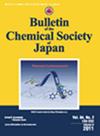通过将非手性偶氮苯衍生物纳入手性控制螺旋纳米纤维,赋予其气光特性
IF 3.8
3区 化学
Q2 CHEMISTRY, MULTIDISCIPLINARY
引用次数: 0
摘要
从手性到非手性有机分子的手性转录是超分子化学、有机化学和纳米科学的一个基础研究领域。在这项研究中,我们证明了通过将非手性偶氮苯衍生物(Azo)嵌入螺旋控制的纳米纤维中,可以实现该衍生物的手性转录。螺旋纳米纤维是由不溶于水的 D-12- 羟基硬脂酸(D-HSA)作为手性源与水溶性长链氨基胺衍生物(C18AA)在水中超分子组装而成。加入偶氮的螺旋纳米纤维在 350 纳米波长处出现圆二色性(CD)峰,该峰被归属于反式偶氮苯发色团的 π-π* 过渡带,表明纳米纤维中偶氮分子呈手性排列。由于纳米纤维分散在水中,而偶氮不溶于水,因此选择溶解偶氮的有机溶剂对于偶氮分子的掺入非常重要。当使用不溶于水的甲苯作为溶剂时,由于纳米纤维与偶氮之间的接触受到抑制,偶氮没有被掺入;但当使用不溶于水的甲醇时,偶氮被掺入。偶氮逐渐掺入到预组装的 C18AA + D-HSA 纳米纤维中,但在形成 C18AA + D-HSA 纳米纤维的过程中没有发生共组装。我们还发现,含偶氮的纳米纤维可以在凝胶态到溶胶态之间发生可逆的热相变,从而开关偶氮的 CD 信号。此外,纳米纤维中嵌入的偶氮的反式-顺式-光异构化消除了反式异构体的 CD 峰,没有出现与顺式异构体相对应的新的 CD 峰。本文章由计算机程序翻译,如有差异,请以英文原文为准。
Imparting chiroptical property to achiral azobenzene derivative via incorporation into chiral-controlled helical nanofibers
Chiral transcription from chiral to achiral organic molecules is a fundamental research area in supramolecular chemistry, organic chemistry, and nanoscience. In this study, we demonstrated that chiral transcription of an achiral azobenzene derivative (Azo) can be achieved by embedding it within helically controlled nanofibers. Helical nanofibers were produced via supramolecular assembly of water-insoluble D-12-hydroxystearic acid (D-HSA) as a chiral source and a water-soluble long-chain amidoamine derivative (C18AA) in water. Azo-incorporated helical nanofibers exhibited a circular dichroism (CD) peak at 350 nm, which was assigned to the π−π* transition band of trans-azobenzene chromophore, suggesting a chiral arrangement of Azo molecules in the nanofibers. Because the nanofibers are dispersed in water and Azo is not soluble in water, the selection of an organic solvent to dissolve Azo is important for the incorporation of Azo molecules. When water-immiscible toluene was used as the solvent, Azo incorporation did not occur, because contact between the nanofibers and Azo was inhibited; however, when water-miscible methanol was used, incorporation was achieved. The incorporation of Azo gradually occurred in the pre-assembled C18AA + D-HSA nanofibers, but co-assembly did not occur during the formation of the C18AA + D-HSA nanofibers. We also showed that Azo-containing nanofibers can undergo a reversible thermal phase transition between gel-to-sol states, switching the CD signal of Azo on and off. Furthermore, trans–cis-photoisomerization of Azo embedded in the nanofibers eliminated the CD peak of the trans-isomer, and no new CD peak corresponding to the cis-isomer appeared.
求助全文
通过发布文献求助,成功后即可免费获取论文全文。
去求助
来源期刊
CiteScore
6.40
自引率
5.00%
发文量
194
审稿时长
3-8 weeks
期刊介绍:
The Bulletin of the Chemical Society of Japan (BCSJ) is devoted to the publication of scientific research papers in the fields of Theoretical and Physical Chemistry, Analytical and Inorganic Chemistry, Organic and Biological Chemistry, and Applied and Materials Chemistry. BCSJ appears as a monthly journal online and in advance with three kinds of papers (Accounts, Articles, and Short Articles) describing original research. The purpose of BCSJ is to select and publish the most important papers with the broadest significance to the chemistry community in general. The Chemical Society of Japan hopes all visitors will notice the usefulness of our journal and the abundance of topics, and welcomes more submissions from scientists all over the world.

 求助内容:
求助内容: 应助结果提醒方式:
应助结果提醒方式:


